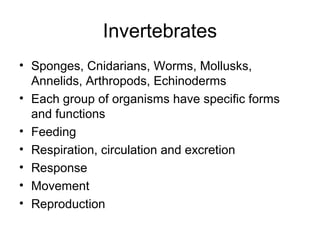
Invertebrates
- 1. Invertebrates • Sponges, Cnidarians, Worms, Mollusks, Annelids, Arthropods, Echinoderms • Each group of organisms have specific forms and functions • Feeding • Respiration, circulation and excretion • Response • Movement • Reproduction
- 2. Worms • Free-living or parasites • Segmented or unsegmented • Flatworms – soft, flattened worms that have tissues and internal organ systems, • simplest animals to have three embryonic germ layers (ectoderm, endoderm, mesoderm), bilateral symmetry and cephalization • Carnivores – single opening for digestive system • Use diffusion to move materials • Use ganglia (bundle of nerve cells) to respond to external stimuli
- 3. Cont. • Cilia and muscles are used for movement • Reproduce using sexual (hermaphordites) or asexual by the process of fission (splitting) • Three groups; • Turbellarians – free-living, fresh or marine water • Flukes – parasitic, internal organs (blood) • Tapeworms-parasitic, intestines
- 4. Nematoda • Roundworms are unsegmented worms that have two opening, anus and mouth • Have specializes tissue and organ systems • Consumers • Diffusion to move materials • Very simple nervous systems for response • Muscles allow for movement • Sexual reproduction – individuals (male and female) • Diseases – trichinosis, elephantiasis,
- 5. Annelids • Segmented bodies, complex organ systems that are unique due to segmented body plan • Filter feeders and predators • Closed circulatory system – dorsal vessel moves toward head and ventral moves toward tail • Aquatic breathe through gills, land through skin
- 6. Cont. • Removes waste from digestion through anus and cellular waste by nephridia • Have a well developed nervous system and fundamental brain to respond to stimuli • Have two major groups of body muscles that function as part of the hydrostatic skeleton for movement – longitudinal head to end (fatter or short) circular around body contract to make worm longer and thinner
- 7. Cont. • Hermaphrodites: have both sperm and eggs • 3 Types of Annelids • Oligochaetes • Leeches • Polychaetes
- 8. Mollusks • Soft-bodied animals that usually have an internal or external shell • Have four parts: foot, mantle, shell, visceral mass • Herbivores, carnivores, filter feeders, detritivores or parasites • Breathe through gills or across skin • Open or closed circulatory systems
- 9. Cont. • Cells release Nitrogen containing waste into the blood in the form of NH3 and removed by nephridia • Simple organisms (clams) have nervous systems made of ganglia, more complex organisms have (octopi) have very complex nervous systems and a highly developed brain
- 10. Cont. • Movement depends on species – snails secrete mucus and move with a rippling motion along – octopus use jet propulsion • Reproduction depends on species – some are hermaphrodites, other release egg and sperm by external fertilization • 3 types of mollusks – • Gastropod, bivalves, cephalopods
- 11. Arthropods • Insects, crabs, centipedes and spiders • Segmented body, tough exoskeleton and jointed appendages • Natural selection and other process has led to fewer body segments, highly specialized appendages for feeding, movement and other functions
- 12. Cont. • Herbivores, carnivores and omnivores • Breathe oxygen through specialized organs (tracheal tubes, book lungs) • Open circulatory system • Excretes waste through specialized organs • Well developed nervous system, ALL have a brain
- 13. Cont. • Movement provided by well developed muscles controlled by nervous system • Internal or external reproduction depending on the species • growth - outgrow exoskeleton by molting • Classified by number and structure of segments and appendages (specifically mouth parts)
- 14. Cont. • Crustaceans, spiders (and relatives), insects (relatives)
- 15. Insects • Body divided into 3 parts – head, thorax (3 pairs of legs attached), abdomen • Use sense organs to respond to stimuli compound eyes, chemical receptors, sensory hairs, well developed ears (beyond human range) • Mouth part used for feeding • Movement uses legs (walking, jumping, holding prey)
- 16. Cont. • Metamorphosis – complete (look nothing like parent) or incomplete (look a lot like parent) • Complex social order system called societies using a “language” to communicate information
- 17. Echinoderms • Spiny skin, internal skeleton, water vascular system, suction structures, exhibit five-part radial symmetry (star fish) • Water vascular system carries out essential body functions respiration, circulation and movement • Sea urchins, sea cucumbers, sea stars • Crown of thorns – major threat to coral
- 18. Evolution • 575 to 543 million years old – Ediacaran • Soft bodied with little specialization • By Cambrian (544 mil yrs) period many had formed shells, skeletons and other hard body parts
- 19. Evolutionary Trends • Specialized cells, tissues, organs • Body symmetry - All invertebrates except sponges exhibit some type of body symmetry • Cephalization – respond to environment in more sophisticated ways • Segmentation – increased body size • Complex animal phyla have a true coelom that is lined completely with tissue derived from mesoderm
- 20. Form and Function • Digestion: Intercellular (digested inside cell) or extracellular (in digestive cavity then absorbed) design • Respiration: large moist surface area in contact with air and water where diffusion can take place • Circulation: move blood through one or more hearts and an open or closed circulator system
- 21. Cont. • Excretory: removal of ammonia aquatic- diffusion / terrestrial ammonia is converted to urea (less toxic) released through excretory pores • Response: 3 trends – centralization (simplest nervous system), cephalization (brain), specialization (sense organs)
- 22. Cont. • Movement and support: 3 main kinds of skeletal systems – hydrostatic (fluid filled), exoskeleton (outside body), endoskeletons (inside body) • Reproduction: sexually and asexually depending on organism – external (outside body) internal (inside body)